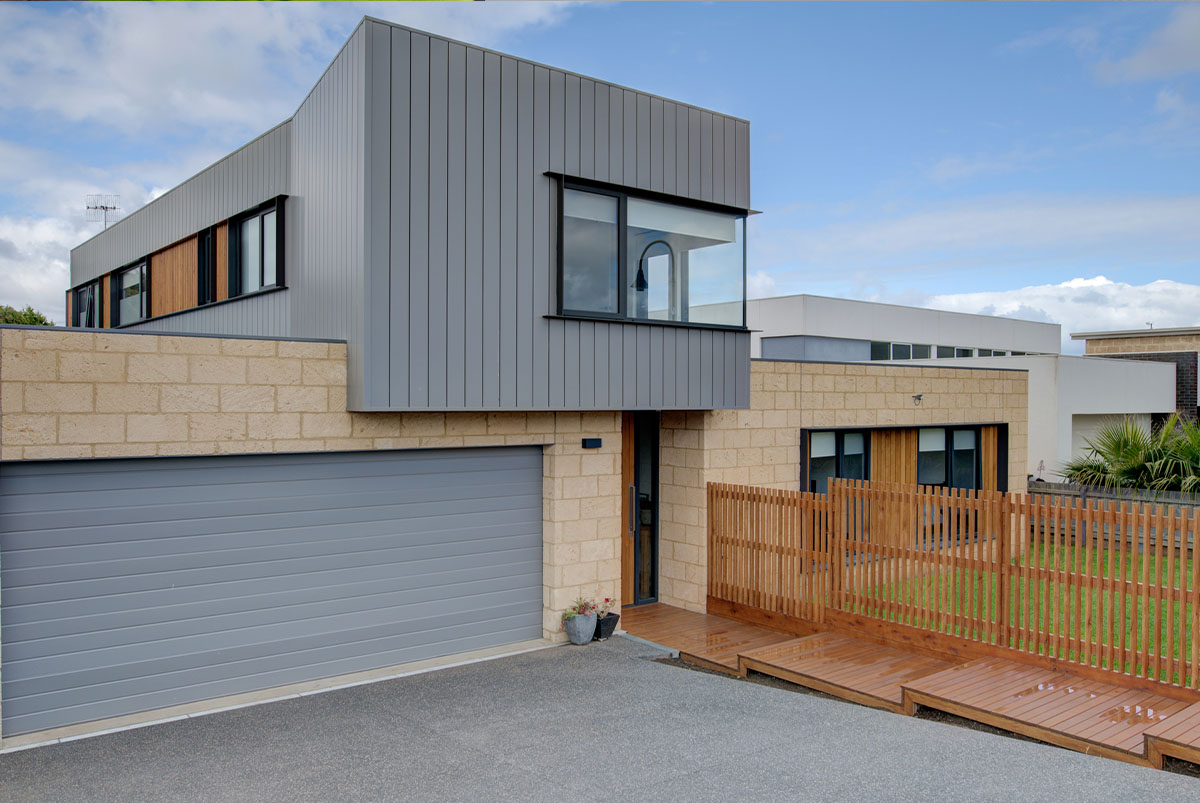Ready To Buy a Home?
Get Approved to Buy a Home
Rocket Mortgage® lets you get to house hunting sooner.
People outside of the real estate world may use terms like modular home and manufactured home interchangeably. This can be confusing to home buyers, since a “prefabricated home” can refer to either type of home. However, there are some important differences between modular and manufactured houses.
The biggest difference is that a modular home is constructed piece-by-piece in a factory and designed to be set up on one plot of land. Alternatively, a manufactured home is built as a single unit, but it typically has a set of wheels so it can be moved as necessary (like a mobile home).
To make the distinction clearer and help you decide which type of home is best for you, we’ll discuss the details concerning modular vs. manufactured homes.
What Is a Modular Home?
A modular home is simply a house that’s built off-site (in a factory) and then assembled on-site. On-site homes or “stick-built homes” (also known as site-built homes) are built on the land where they will reside. Modular homes are constructed in a facility and transported to the building site when they’re finished.
Some modular homes are completely built prior to transportation, while others may be constructed and transported in sections that are quickly reassembled on-site. Either way, a modular home is largely built in a separate location.
Prospective home builders choose modular homes over traditional, on-site homes for a variety of reasons. First and foremost, they tend to be cheaper. On average, modular homes cost 10% – 15% less than comparable stick-built homes.[1]
Modular homes also take much less time to build. They are constructed in a highly controlled, regulated, indoor environment, as opposed to stick-built home construction sites, which may have delays based on sunlight and weather conditions – just to name a few.
However, when it comes to overall quality, taxation, local building codes, zoning and mortgages, there are virtually no differences between a modular home and a traditional home. That said, some people still see modular homes as less valuable than stick-built homes, though that perception has waned as manufacturing techniques and customization options have improved. The standard floor plans of modular homes vary, giving future homeowners tons of options to build their dream home.
What Is a Manufactured Home?
Like a modular home, a manufactured home is constructed in a factory. However, a manufactured home is built on a steel chassis, as opposed to the permanent foundations used with modular or stick-built homes. Manufactured homes are often fitted with wheels so they can be easily transported from one location to another. Unlike modular and traditional homes, manufactured homes aren’t considered part of the land for the purposes of resale or taxation.
For example, if you buy a manufactured home and a piece of land, the manufactured home will not add value to the land in the same way a modular or stick-built home would. This is because you can move the home to a different location at any time.
Additionally, manufactured homes don’t appreciate in value like most other types of homes. On the contrary, manufactured homes actually lose value, similar to how a car loses value over time.
What is a mobile home?
Many people refer to manufactured homes as mobile homes, even though this is an outdated term. In fact, the only difference between a mobile home and a manufactured home depends on when they were created.
Any factory-built home made before June 1976 is a mobile home, while any factory-built home made after that date is a manufactured home.[2] Therefore, a mobile home and a manufactured home are essentially the same thing. There’s just different terminology based on the manufacturing date.
What Are the Differences Between Modular and Manufactured Homes?
Now that you know a little more about modular and manufactured homes, let’s look at the most important differences between the two:
Modular Homes | Manufactured Homes | |
| Construction | Factory-built sections delivered and assembled on the home site | One factory-made unit delivered to the home site |
| Foundation | Permanent (like a stick-built home) | Steel chassis (attached to the home, not the ground) |
| Mobility | Not mobile | Mobile |
| Financing | Standard | Limited |
| Customization | Higher (can add on additional sections as desired) | Lower (Add-ons are limited as these homes are specifically designed to be mobile) |
| Building code requirements | Local, state and regional codes | Federal HUD code |
| Home site | Private property | Private property or land-lease |
| Home cost | Higher (Costs are closer to a traditional home) | Lower (Costs are significantly lower than both modular and stick-built homes) |
| Long-term value | Varies with the market (has the ability to appreciate in value) | Tends to depreciate with time |
Are Modular or Manufactured Homes Better?
So which is better, a modular or manufactured home? Most people would agree that it depends on your needs.
Modular homes are probably better if you want to stay in one place and have a home that can gain value with time. Alternatively, manufactured homes are usually better if you want a cheaper option that also gives you the freedom to move from one location to another without needing to change homes.
For home buyers, both the quality and lasting value of modular homes tend to make a better investment than manufactured homes. Even if you’re worried about the higher price tag, you have more financing options with a modular home, allowing you to pay down a traditional mortgage over time. You typically won’t get this opportunity with a manufactured home.
But do modular homes hold their value? While modular homes have much better resale value than manufactured homes, they can often be hard to close on the real estate market.
Stick-built homes are generally preferred by buyers, which means you may have to keep your modular house listed for a long time or drop the price to sell it. So even though modular homes do often appreciate, it can be difficult to actually get their full value when it comes time to sell.
Which is cheaper, modular or manufactured homes?
As previously mentioned, manufactured homes tend to be much cheaper than modular homes. As of 2021, the average price for a manufactured home in the United States was $108,000.[3] This price varies based on the size of the home (single wide or double wide).
Alternatively, a modular home costs about $150 per square foot (including installation), making the current average price for a modular home roughly $270,000.[4]
What are the advantages and disadvantages of modular homes?
Here are some of the key advantages and disadvantages of modular homes:
PROS of Modular Homes👍
CONS of Modular Homes👎
What are the advantages and disadvantages of manufactured homes?
Here are some of the key advantages and disadvantages of manufactured homes:
PROS of Manufactured Homes👍
CONS of Manufactured Homes👎
Can I Finance Modular and Manufactured Homes?
Yes, you can finance modular and manufactured homes. However, modular homes are easier to finance because most lenders treat them the same as traditional houses. This is primarily because a modular home is fixed to one location using a standard foundation, ensuring it meets the requirements set by most mortgage lenders.
Unfortunately, manufactured homes can be more difficult to finance. Most lenders don’t offer the option to finance a manufactured home. So you may have to look for other ways to finance your purchase, like a personal loan or a payment plan through the manufacturer.
It’s All About the Foundation
While one of the biggest differences between modular and manufactured homes is the foundation, it’s a very important distinction. From financing to land ownership, modular and manufactured homes offer two very different experiences to consumers buying a new home.
Though modular homes generally offer a better long-term investment, the best choice will depend on your personal tastes, needs and finances.
Take the first step toward buying a home.
Get approved. See what you qualify for. Start house hunting.
The Short Version
- A modular home is simply a house that’s built off-site (in a factory) and then assembled on-site
- A manufactured home is built on a steel chassis, as opposed to the permanent foundations used with modular or stick-built homes
- For home buyers, both the quality and lasting value of modular homes tend to make a better investment than manufactured homes
United States Census Bureau. “MHS Annual Data.” Retrieved August 2022 from https://www.census.gov/data/tables/time-series/econ/mhs/annual-data.html
Department of Housing and Urban Development. “Manufactured Housing and Standards- Frequently Asked Questions | HUD.gov / U.S. Department of Housing and Urban Development.” Retrieved August 2022 from https://www.hud.gov/program_offices/housing/rmra/mhs/faqs
Remodeling Calculator. “2022 Prefab Home Prices, Design Options, Pros & Cons.” Retrieved August 2022 from https://www.remodelingcalculator.org/prefab-home-prices/
HomeAdvisor. “Modular Home Kits and Construction Costs How Much Are Modular Homes?” Retrieved August 2022 from https://www.homeadvisor.com/cost/architects-and-engineers/modular-home-prices/




